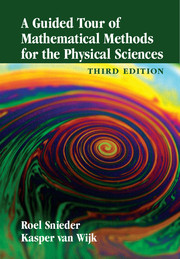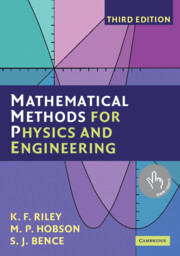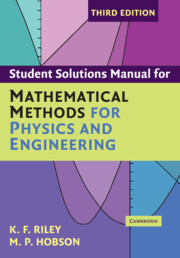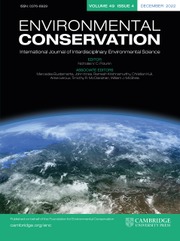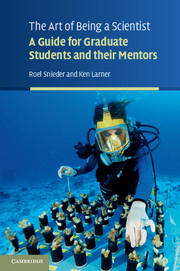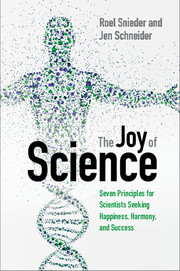A Guided Tour of Mathematical Methods for the Physical Sciences
3rd Edition
- Authors:
- Roel Snieder, Colorado School of Mines
- Kasper van Wijk, University of Auckland
- Date Published: March 2015
- availability: Available
- format: Paperback
- isbn: 9781107641600
Paperback
Other available formats:
Hardback, eBook
Looking for an inspection copy?
Please email [email protected] to enquire about an inspection copy of this book
-
Mathematical methods are essential tools for all physical scientists. This book provides a comprehensive tour of the mathematical knowledge and techniques that are needed by students across the physical sciences. In contrast to more traditional textbooks, all the material is presented in the form of exercises. Within these exercises, basic mathematical theory and its applications in the physical sciences are well integrated. In this way, the mathematical insights that readers acquire are driven by their physical-science insight. This third edition has been completely revised: new material has been added to most chapters, and two completely new chapters on probability and statistics and on inverse problems have been added. This guided tour of mathematical techniques is instructive, applied, and fun. This book is targeted for all students of the physical sciences. It can serve as a stand-alone text, or as a source of exercises and examples to complement other textbooks.
Read more- All material presented as problems, which directly engages the reader
- Appeals to students' interest in the physical sciences
- A practical application of mathematics in the physical sciences
Reviews & endorsements
'[This] is an excellent textbook for young people to acquire practical mathematical methods; furthermore, it is a wonderful guidebook for them to learn a mathematical thinking style. I highly recommend this splendid book to students and teachers in [the] sciences.' Haruo Sato, Tohoku University, Japan
See more reviews'A delight of a book, original, and highly informative with many hidden gems. A must for the physical scientist. Using calculus to show why life is not possible in a five dimensional world was just one piece of magic.' Malcolm Sambridge, Australian National University
'Two bright minds [have] created a fantastic set of physical problems that opens the gates to the understanding of mathematical physics for undergraduate and graduate students alike. Solving these problems is not only instructive, but fun - almost addictive.' Jurgen Neuberg, University of Leeds
'Snieder and van Wijk have written a book that offers a refreshing alternate approach to the learning (and appreciation) of mathematical methods, in which the methods are introduced and illustrated by explicit problems in the physical sciences. For persons who genuinely like mathematics, and who want to strengthen their problem solving capabilities, but who nevertheless want to keep their focus on the physics, this book is highly recommended for self-study and leisure reading.' Allan D. Pierce, Boston University and the Acoustical Society of America
'The third edition builds on the strengths of the earlier editions and is insightful, accessible and enjoyable to read. Exercises are nicely woven into the fabric of the text to more fully engage the reader. Chapters on 'Probability and Statistics' and 'Inverse Problems' are important new additions.' Robert L. Nowack, Purdue University and the Journal of Geophysical Research: Solid Earth
'[A Guided Tour of] Mathematical Methods for the Physical Sciences introduces the tools required to describe and interpret the physical world. Using clear, instructive examples, Snieder and van Wijk demonstrate how to tackle complex problems step by step and how to develop an understanding of what equations really mean.' John Townend, Victoria University of Wellington, New Zealand
'This book makes learning difficult mathematics easier. Each concept is presented through a series of clear explanations and tractable problems, so students gain both the understanding, and the ability to use mathematics in any field. You can't ask for more from a maths book.' Andrew Curtis, University of Edinburgh
Review of previous edition: '… a splendid book … excellent.' International Journal of Numerical Modelling
Review of previous edition: 'The publisher says that this book is 'instructive, applied and fun'. I agree …' Times Higher Education Supplement
Review of previous edition: 'I can highly recommend this book to students and teachers in the physical sciences.' Astronomy and Geophysics
Review of previous edition: 'Guided by [this] textbook, learning mathematical methods can be fun … I highly recommend [it].' Eos, Transactions, American Geophysical Union
Review of previous edition: '[The] clear, simplistic approach is highly recommended for both students and teachers alike … highly informative, written with authority, fascinating to read.' Materials World
'The first and second editions of this gem of a volume were received with praise such as 'a delight of a book', 'a fantastic set of physical problems that opens the gate to the understanding of mathematical physics', and 'a refreshing alternative approach', among many others. It is difficult to find better words to describe the third edition … It is student-friendly not only in its clarity and elegance of style … The volume is both a finely honed learning tool and a good reference for most of the mathematics that a geophysicist might encounter in practice … In short, here is a book that no practicing geophysicist … should be without.' Sven Treitel, The Leading Edge
Customer reviews
Not yet reviewed
Be the first to review
Review was not posted due to profanity
×Product details
- Edition: 3rd Edition
- Date Published: March 2015
- format: Paperback
- isbn: 9781107641600
- length: 579 pages
- dimensions: 254 x 178 x 25 mm
- weight: 1.22kg
- contains: 153 b/w illus. 10 tables
- availability: Available
Table of Contents
1. Introduction
2. Dimensional analysis
3. Power series
4. Spherical and cylindrical coordinates
5. Gradient
6. Divergence of a vector field
7. Curl of a vector field
8. Theorem of Gauss
9. Theorem of Stokes
10. The Laplacian
11. Scale analysis
12. Linear algebra
13. Dirac delta function
14. Fourier analysis
15. Analytic functions
16. Complex integration
17. Green's functions: principles
18. Green's functions: examples
19. Normal modes
20. Potential-field theory
21. Probability and statistics
22. Inverse problems
23. Perturbation theory
24. Asymptotic evaluation of integrals
25. Conservation laws
26. Cartesian tensors
27. Variational calculus
28. Epilogue on power and knowledge.-
General Resources
Find resources associated with this title
Type Name Unlocked * Format Size Showing of
This title is supported by one or more locked resources. Access to locked resources is granted exclusively by Cambridge University Press to lecturers whose faculty status has been verified. To gain access to locked resources, lecturers should sign in to or register for a Cambridge user account.
Please use locked resources responsibly and exercise your professional discretion when choosing how you share these materials with your students. Other lecturers may wish to use locked resources for assessment purposes and their usefulness is undermined when the source files (for example, solution manuals or test banks) are shared online or via social networks.
Supplementary resources are subject to copyright. Lecturers are permitted to view, print or download these resources for use in their teaching, but may not change them or use them for commercial gain.
If you are having problems accessing these resources please contact [email protected].
Sorry, this resource is locked
Please register or sign in to request access. If you are having problems accessing these resources please email [email protected]
Register Sign in» Proceed
You are now leaving the Cambridge University Press website. Your eBook purchase and download will be completed by our partner www.ebooks.com. Please see the permission section of the www.ebooks.com catalogue page for details of the print & copy limits on our eBooks.
Continue ×Are you sure you want to delete your account?
This cannot be undone.
Thank you for your feedback which will help us improve our service.
If you requested a response, we will make sure to get back to you shortly.
×
